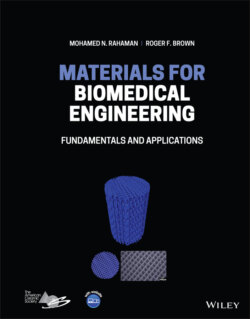Читать книгу Materials for Biomedical Engineering - Mohamed N. Rahaman - Страница 24
1.3.1 Evolving Trend in Biomaterials Design
ОглавлениеIn the past, materials science and engineering provided the foundation for designing and selecting biomaterials. Biomaterials were normally selected from durable, chemically inert materials that were available off the shelf, and they were engineered to serve a mainly mechanical (or physical) function. Adequate strength and stiffness, for example, are required for the biomaterial to support physiological stresses without deforming permanently into a nonoptimal shape or without fracturing. Chemical inertness is important to minimize the potential for rejection of the biomaterial.
This approach based on materials science and engineering worked well for some applications and it provided a foundation for more recent developments in the biomaterials field. On the other hand, clinical data show that a high percentage of these biomaterials failed within a certain duration, necessitating a second surgical procedure (sometimes referred to as a revision surgery). Implants used for total hip joint replacement are a good example of this approach (Section 1.5). While the basic design of the hip implant has changed very little in over 50 years, improvements in materials selection over this time have resulted in the creation of implants having better performance and longer lifetime in vivo. However, ~25% of these implants still fail within 10–20 years, necessitating revision surgery.
The last few decades have seen a radical shift in the approach to designing and selecting biomaterials. Biological sciences are now playing a significant role, often comparable to that of materials science and engineering. Advances in biological sciences are being utilized to design biomaterials that serve not just a mechanical (or physical) function. Instead, biomaterials are now being designed to serve, in addition, biological functions such as eliciting or directing specific cellular responses. At the same time, advances in the physical sciences, materials science and engineering are being used to design and create improved biomaterials with greater complexity in structural and chemical characteristics to better mimic biological tissues.
As an example of the shift in biomaterials design over the last few decades, we can select the intravascular stent (Figure 1.1g). This device is among the most widely used of all implantable medical devices, with over 1.5 million stents implanted annually in patients worldwide. Stents are used when a blood vessel such as an artery becomes blocked (a process referred to as stenosis) due to the accumulation of plaque, a condition that, in many cases, can lead to a heart attack. Stents are tubular in shape and they are inserted into the artery to compress the plaque and to remain at the site to keep the artery open (Chapter 24).
Until recently, stent designs focused strongly on the need to provide a mechanical function. This called for the use of a biocompatible metal with the attractive mechanical properties characteristic of this class of materials and corrosion resistance to minimize the chances of rejection in vivo. Early stent designs employed durable metals that were available off the shelf, such as a stainless steel or a cobalt–chromium (Co–Cr) alloy (Figure 1.4). Although these so‐called bare‐metal stents work well initially, they themselves can become blocked after a few years (a process referred to as restenosis). A problem with bare‐metal stents is that they can irritate the endothelial lining of the artery. This triggers an inflammatory response, which leads to the proliferation of certain cells (vascular smooth muscle cells) and the growth of extracellular fibrotic tissue into the lumen of the stent, resulting in restenosis. The result is that the procedure may have to be repeated at regular intervals.
Figure 1.4 Stages in the evolution of the intravascular stent, used as an example to illustrate the considerable shift in biomaterials design over the last few decades.
Modern metal stents are designed to serve the mechanical function of bare‐metal stents but to also provide a biological function to reduce restenosis. The biological function of controlling cell proliferation and the growth of fibrotic tissue into the stent is achieved by incorporating a drug‐eluting function into the stent. In one approach, a thin coating of a polymer, degradable or nondegradable, in which the drug is dispersed, is applied to the stent surface. Commonly used drugs include paclitaxel and sirolimus, both of which are powerful antiproliferative drugs that inhibit cell proliferation. The use of these drug‐eluting stents has produced a significant lowering of restenosis rates, but they have not been entirely successful. A problem is that the stent can provide sites for aggregation of platelets (from the blood), resulting in thrombosis, which normally necessitates prolonged antiplatelet therapy.
Questions have been raised about the need for the continued presence of the stent after stenosis has been resolved. It has been claimed that the benefit of the drug‐eluting stent is achieved within a finite time, such as a few months, and the continued presence of the stent contributes to adverse biological effects due to its ability to irritate the endothelium of the artery. Consequently, a more recent approach to the design of modern stents is the use of a degradable stent, composed of a degradable polymer in which the drug is dispersed or a degradable metal coated with a degradable polymer in which the drug is dispersed. The stent serves a mechanical function initially to open up the blocked blood vessel and, as it degrades, the drug is released at a controllable rate to destroy the deposit responsible for stenosis. After resolution of stenosis, the stent degrades completely. While drug‐eluting degradable stents provide a useful alternative approach to treating stenosis; a few questions related to their effectiveness remain unresolved at the present time. One is the degree of inflammatory response by cells to the degradation products of the polymer stent and the effect of this response on the endothelium of the blood vessel.
